Introducing Object Detection
- Suppose we want to detect cars in images and videos
- This process involves object detection
- Object detection is a type of supervised classification
- Therefore, we need to train a network on a large number of input images of cars
- Having more images will lead to more accurate predictions of whether an image has a car or not
- This network would return a binary output of whether there is a car or not
- This network would also return the coordinates representing a bounding box around the car
-
The following are the general steps for object detection:
- Train a convolutional network on images of cars
- Perform sliding windows detection on live video or new images
- Output a list of bounding boxes around any cars if they exist
Algorithm for Sliding Windows Detection
-
Initialize a window size
- The window size represents the size on an image that will be trained on our convolution al network
-
Select a region of our image
- This region is based on the window size
-
Input this image region into our convolutional network
- This convolutional network should be already trained on many images
-
Receive output from the convolutional network
- The output is our prediction of whether the image is a car or not
-
Repeat steps 2-4
- In other words, iterate through the image, shift the window to a slightly different region, and input that new region into our convolutional network
- Continue to do this until we have iterated through the entire image
-
Repeat steps 2-5
- After returning to step 2, we should increase the window size
- In other words, increase the window size after iterating through the entire image
- Then, input the image region into the convolutional network while shifting the window to a slightly different region of the image afterwards
- We should keep increasing the window size 2-3 times

Describing Sliding Window Detection
- Sliding window detection involves sliding a window across an entire image
- Then, each square region within the window is classified
- A stride hyperparameter determines how much the window slides across the image
- In other words, a stride hyperparameter determines the step size
-
Therefore, there becomes a trade-off between accuracy and performance:
- A larger stride can lead to decreased accuracy and increased performance
- A smaller stride can lead to decreased performance and increased accuracy
-
The computational cost grows quickly because:
- We're cropping out so many square regions in the image
- Running each of these regions independently in a convolutional network
- Implementing sliding window detection within our convolutional network can help increase performance
Converting FC Layers into Convolutional Layers
- As we've hinted at already, a convolutional layer can be thought of as a fully-connected layer with nuerons
- Mathematically, these layers are the same
- Specifically, an image convolved with each of the number of filters leads to the image
- Therefore, each of the number of filters is a linear function of the activations made up by the previous image
- For example, a image convolved with filters becomes a convolutional layer
- Each of the filters is made up of weights
- So, convolving the filters with the image is essentially performing where is a linear activation function
Implementing Sliding Window Convolutionally
- Let's return to our sliding window problem
- Rather than iteratively inputting each sliding window region into our network, we can convolutionally perform the predictions all at once
- We can do this by using convolutional layers in place of fully-connected layer
tldr
- Sliding window detection involves sliding a window across an entire image
- Then, each square region within the window is classified
- A stride hyperparameter determines how much the window slides across the image
- In other words, a stride hyperparameter determines the step size
References
Previous
Next